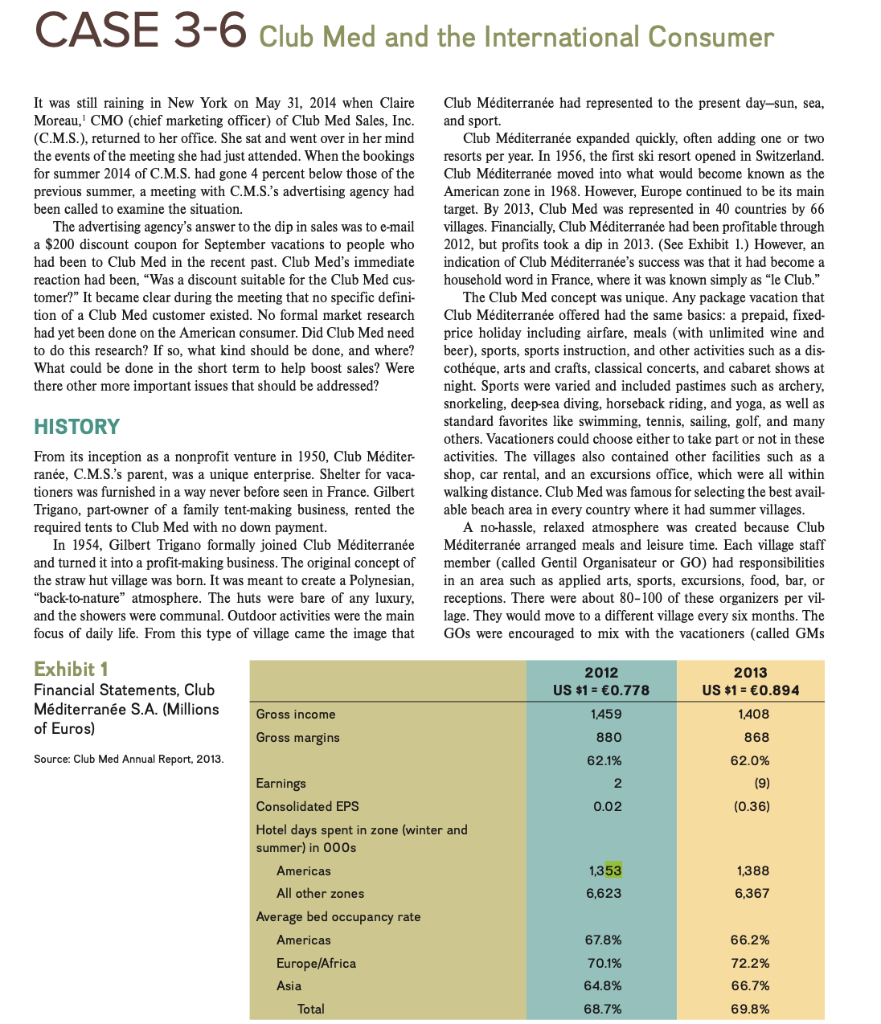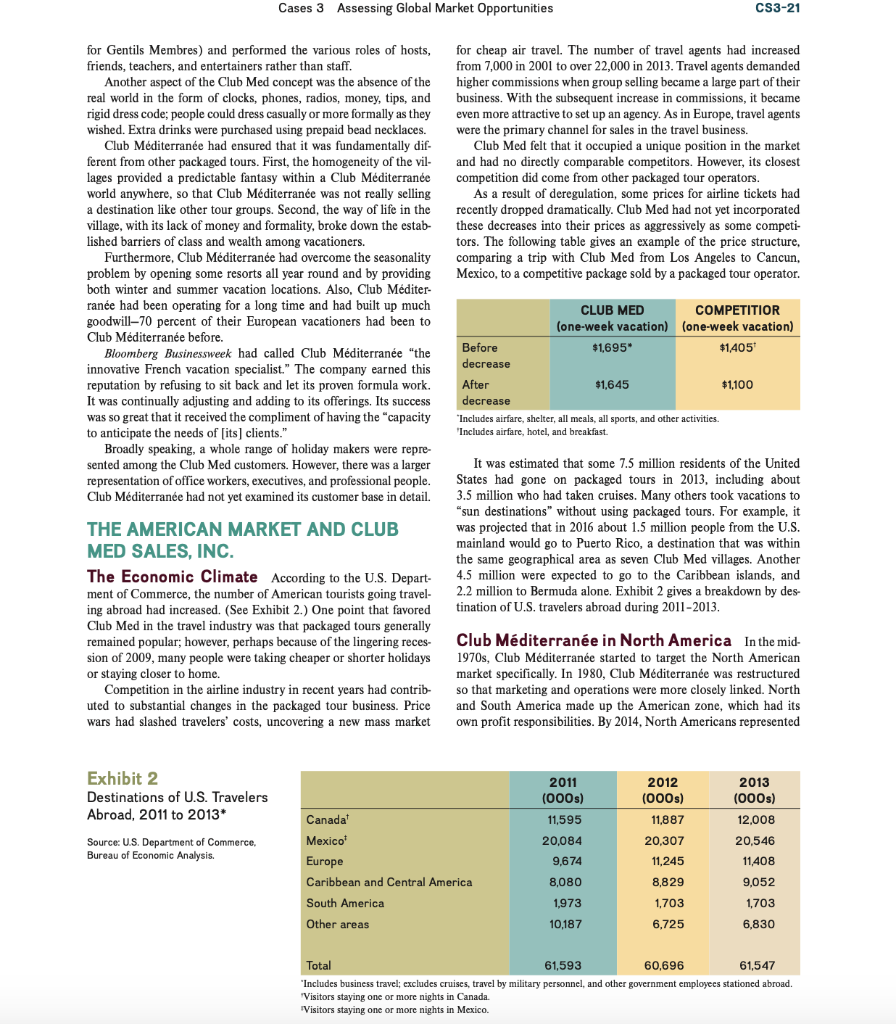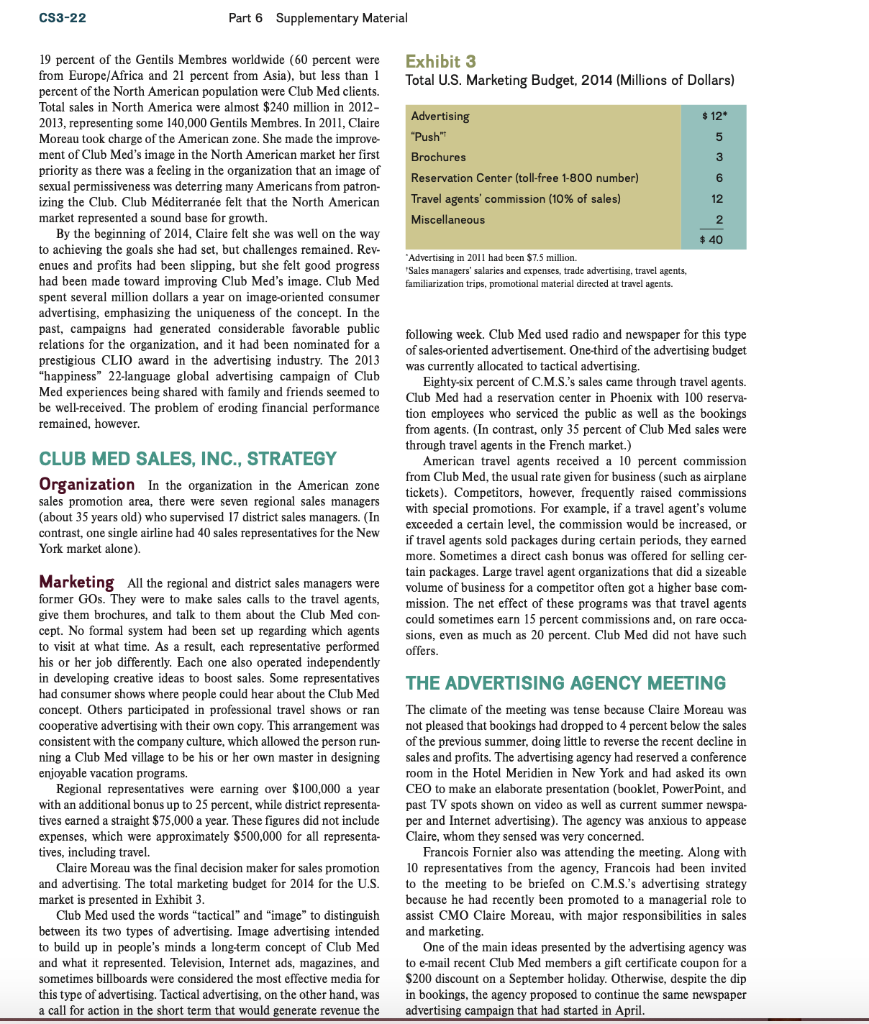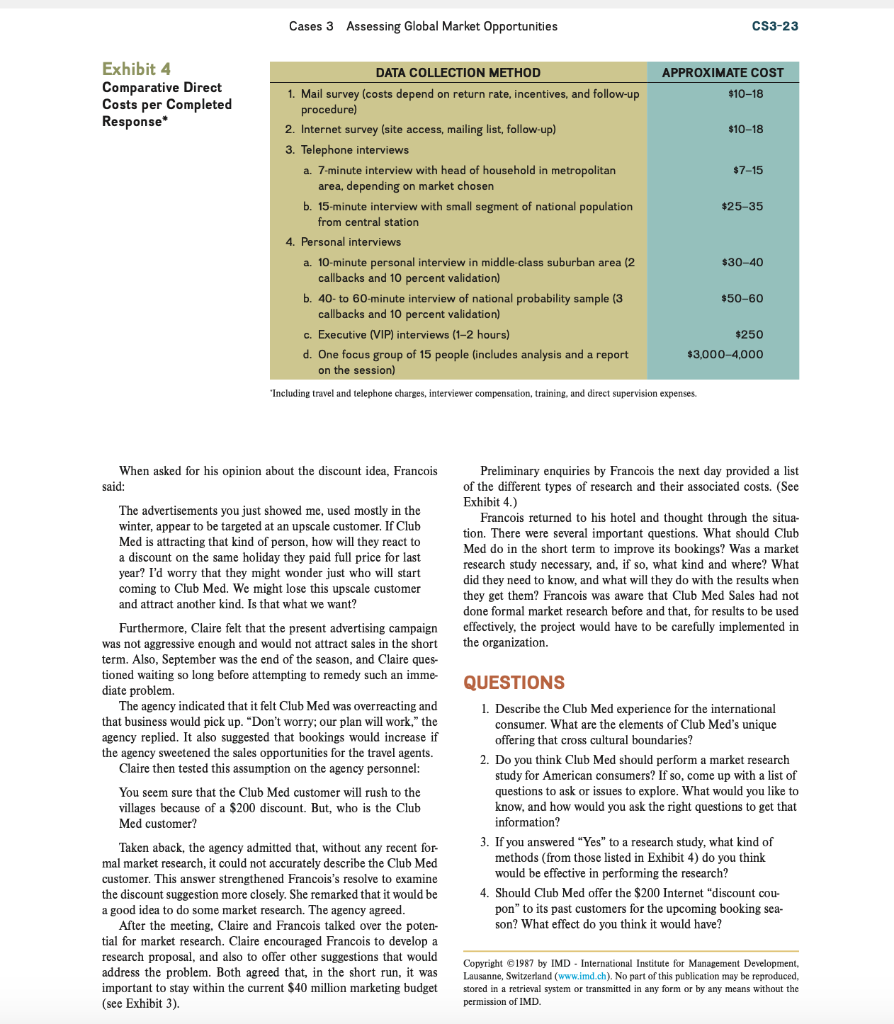Answered step by step
Verified Expert Solution
Question
1 Approved Answer
Just need a summary about the case. DO NOT ANSWER THE QUESTIONS!! I will down vote immediately. Follow direction. I just need a case summary.




Just need a summary about the case. DO NOT ANSWER THE QUESTIONS!! I will down vote immediately. Follow direction. I just need a case summary.
CASE 3-6 Club Med and the International Consumer It was still raining in New York on May 31, 2014 when Claire Moreau,' CMO (chief marketing officer) of Club Med Sales, Inc. (C.M.S.), returned to her office. She sat and went over in her mind the events of the meeting she had just attended. When the bookings for summer 2014 of C.M.S. had gone 4 percent below those of the previous summer, a meeting with C.M.S.'s advertising agency had been called to examine the situation. The advertising agency's answer to the dip in sales was to e-mail a $200 discount coupon for September vacations to people who had been to Club Med in the recent past. Club Med's immediate reaction had been, "Was a discount suitable for the Club Med cus- tomer?" It became clear during the meeting that no specific defini- tion of a Club Med customer existed. No formal market research had yet been done on the American consumer. Did Club Med need to do this research? If so, what kind should be done, and where? What could be done in the short term to help boost sales? Were there other more important issues that should be addressed? Club Mditerrane had represented to the present day-sun, sea, and sport. Club Mditerrane expanded quickly, often adding one or two resorts per year. In 1956, the first ski resort opened in Switzerland. Club Mditerrane moved into what would become known as the American zone in 1968. However, Europe continued to be its main target. By 2013, Club Med was represented in 40 countries by 66 villages. Financially, Club Mditerrane had been profitable through 2012, but profits took a dip in 2013. (See Exhibit 1.) However, an indication of Club Mditerrane's success was that it had become a household word in France, where it was known simply as le Club." The Club Med concept was unique. Any package vacation that Club Mditerrane offered had the same basics: a prepaid, fixed- price holiday including airfare, meals (with unlimited wine and beer), sports, sports instruction, and other activities such as a dis- cothque, arts and crafts, classical concerts, and cabaret shows at night. Sports were varied and included pastimes such as archery, snorkeling, deep-sea diving, horseback riding, and yoga, as well as standard favorites like swimming, tennis, sailing, golf, and many others. Vacationers could choose either to take part or not in these activities. The villages also contained other facilities such as a shop, car rental, and an excursions office, which were all within walking distance. Club Med was famous for selecting the best avail- able beach area in every country where it had summer villages. A no-hassle, relaxed atmosphere was created because Club Mditerrane arranged meals and leisure time. Each village staff member called Gentil Organisateur or GO) had responsibilities in an area such as applied arts, sports, excursions, food, bar, or receptions. There were about 80-100 of these organizers per vil- lage. They would move to a different village every six months. The GOs were encouraged to mix with the vacationers (called GMs HISTORY From its inception as a nonprofit venture in 1950, Club Mditer- rane, C.M.S.'s parent, was a unique enterprise. Shelter for vaca- tioners was furnished in a way never before seen in France. Gilbert Trigano, part-owner of a family tent-making business, rented the required tents to Club Med with no down payment. In 1954, Gilbert Trigano formally joined Club Mditerrane and turned it into a profit-making business. The original concept of the straw hut village was born. It was meant to create a Polynesian, "back-to-nature atmosphere. The huts were bare of any luxury, and the showers were communal. Outdoor activities were the main focus of daily life. From this type of village came the image that Exhibit 1 Financial Statements, Club Mditerrane S.A. (Millions of Euros) 2012 US $1 = 0.778 1,459 2013 US $1 = 0.894 1,408 Gross income Gross margins 880 868 Source: Club Med Annual Report, 2013 62.1% 62.0% 2 (9) 0.02 (0.36) 1,388 Earnings Consolidated EPS Hotel days spent in zone (winter and summer) in 000s Americas All other zones Average bed occupancy rate Americas Europe/Africa Asia 1,353 6,623 6,367 66.2% 67.8% 70.1% 72.2% 66.7% 64.8% 68.7% Total 69.8% Cases 3 Assessing Global Market Opportunities CS3-21 Club felt that it occupied a uniqu sition in the market ferent First, the for cheap air travel. The number of travel agents had increased from 7,000 in 2001 to over 22,000 in 2013. Travel agents demanded higher commissions when group selling became a large part of their business. With the subsequent increase in commissions, it became even more attractive to set up an agency. As in Europe, travel agents were the primary channel for sales in the travel business. Club Med felt that it occur unique position in and had no directly comparable competitors. However, its closest competition did come from other packaged tour ope operators. As f deregulation, some prices for airline tickets had recently dropped dramatically. Club Med had not yet incorporated these decreases into their prices as aggressively as some competi- tors. The following table gives an example of the price structure, comparing a trip with Club Med from Los Angeles to Cancun, Mexico, to a competitive package sold by a packaged tour operator. a Club was not really selling a result for Gentils Membres) and performed the various roles of hosts, friends, teachers, and entertainers rather than staff. Another aspect of the Club Med concept was the absence of the real world in the form of clocks, phones, radios, money, tips, and rigid dress code; people could dress casually or more formally as they wished. Extra drinks were purchased using prepaid bead necklaces. Mditerrane had ensured that it was fundamentally dif- from other packaged tours. the homogeneity of the vil- lages provided a predictable fantasy within a Club Mditerrane world anywhere, so that Mditerrane was not a destination like other tour groups. Second, the way of life in the with its lack of money and formality, broke down the estab- lished of class and wealth among vacationers. Furthermore, Club Mditerrane had overcome overcome the seasonality problem by opening some resorts all year round and by providing both winter and summer winter and summer vacation locations. Also, Club Mditer- been operating ating for a long time and had built up much goodwill-70 percent of their European vacationers had been to Club Mditerrane before. Bloomberg Businessweek had called Club Mditerrane "the innovative French vacation specialist." The company earned this reputation to sit back and let its proven formula work. It t was continually adjusting and adding to its offerings. Its success was so great that it received the compliment of having the "capacity to anticipate the needs of its] clients." Broadly speaking, a whole range of holiday makers were repre- sented among the Club Med customers. However, there was a larger representation of office workers, executives, and professional people. Club Mditerrane had not yet examined its customer base in detail. village, with its harris rane had been ation by refusing to CLUB MED COMPETITIOR (one-week vacation) (one-week vacation) Before $1,695 $1,405 decrease After $1,645 $1,100 decrease "Includes airfare, shelter, all meals, all sports, and other activities. "Includes airfare, hotel, and breakfast. It was estimated that some million residents of the United States had gone on packaged tours in 2013, including about 3.5 million who had taken cruises. Many others took vacations to "sun destinations" without using packaged tours. For example, it was projected that in 2016 about 1.5 million people from the U.S. mainland would go to Puerto Rico, a destination that was within the same geographical area as seven Club Med villages. Another 4.5 million were expected to go to the Caribbean islands, and 2.2 million to Bermuda alone. Exhibit 2 gives a breakdown by des- tination of U.S. travelers abroad during 2011-2013. THE AMERICAN MARKET AND CLUB MED SALES, INC. The Economic Climate According to the U.S. Depart- ment of Commerce, the number of American tourists going travel- ing abroad had increased. (See Exhibit 2.) One point that favored Club Med in the travel industry was that packaged tours generally remained popular; however, perhaps because of the lingering reces- sion of 2009, many people were taking cheaper or shorter holidays or staying closer to home. Competition in the airline industry in recent years had contrib- uted to substantial changes in the packaged tour business. Price wars had slashed travelers' costs, uncovering a new mass market Club Mditerrane in North America In the mid- 1970s, Club Mditerrane started to target the North American market specifically. In 1980, Club Mditerrane was restructured so that marketing and operations were more closely linked. North and South America made up the American zone, which had its own profit responsibilities. By 2014, North Americans represented Exhibit 2 Destinations of U.S. Travelers Abroad, 2011 to 2013* 2013 (000s) 12,008 20,546 Source: U.S. Department Commerce Bureau of Economic Analysis. 2011 (000s) 11,595 20,084 9,674 8,080 1,973 Canada Mexico Europe Caribbean and Central America South America 2012 (000s) 11,887 20.307 11,245 8,829 1,703 6,725 11408 9,052 1,703 Other areas 10,187 6,830 Total 61,593 60,696 61,547 "Includes business travel; excludes cruises, travel by military personnel, and other government employees stationed abroad. Visitors staying one or more nights in Canada. Visitors staying one or more nights in Mexico. CS3-22 Part 6 Supplementary Material Exhibit 3 Total U.S. Marketing Budget 2014 (Millions of Dollars) $ 12* 5 3 Advertising "Push" Brochures Reservation Center (toll-free 1-800 number) Travel agents' commission (10% of sales) Miscellaneous 6 12 19 percent of the Gentils Membres worldwide (60 percent were from Europe/Africa and 21 percent from Asia), but less than percent of the North American population were Club Med clients. Total sales in North America were almost $240 million in 2012- 2013, representing some 140,000 Gentils Membres. In 2011, Claire Moreau took charge of the American zone. She made the improve ment of Club Med's image in the North American market her first priority as there was a les organization that an image of sexual permissiveness was deterring many Americans from patron izing the Club. Club Mditerrane felt that the North American market represented a sound base for growth. By the beginning of 2014, Claire felt she was well on the way to achieving the goals she had set, but challenges remained. Rev- enues and profits had been slipping, but she felt , good had been made Club Med's Club Med spent several million dollars a year on image-oriented consumer advertising, emphasizing the In the past, campaigns had generated considerable favorable public relations for the organization, and it had been nominated for prestigious CLIO award in the advertising industry. The 2013 "happiness" 22-language global advertising campaign of Club Med experiences being shared with family and friends seemed to be well-received. The problem of eroding financial performance remained, however. 2 $ 40 progress image "Advertising in 2011 had been $7.5 million. Sales managers' salaries and expenses, trade advertising, travel agents, familiarization trips, promotional material directed at travel agents. toward impro improving the uniqueness of of the conce concept CLUB MED SALES, INC., STRATEGY Organization in the organization in the American zone sales promotion area, there were seven regional sales managers (about 35 years old) who supervised 17 district sales managers. (In contrast, one single airline had 40 sales representatives for the New York market alone) following week. Club Med used radio and newspaper for this type of sales-oriented advertisement. One-third of the advertising budget was currently allocated to tactical advertising. Eighty-six percent of C.M.S.'s sales came through travel agents. Club Med had a reservation center in Phoenix with 100 reserva- tion employees who serviced the public as well as the bookings from agents. (In contrast, only 35 percent of Club Med sales were through travel agents in the French market.) American travel agents received a 10 percent commission from Club Med, the usual rate given for business (such as airplane tickets). Competitors, however, frequently raised commissions with special promotions. For For example, if a travel agent's volume exceeded a certain level, the commission would be increased, or if travel agents sold packages during certain periods, they earned more. Sometimes a direct cash bonus was offered for selling cer- tain packages. Large travel agent organizations that did a sizeable volume of business for a competitor often got a higher base com- mission. The net effect of these programs was that travel agents could sometimes earn 15 percent commissions and, on rare occa- sions, even as much as 20 percent. Club Med did not have such offers. a had Marketing All the regional and district sales managers were former GOs. They were to make sales calls to the travel agents, give them brochures, and talk to them about the Club Med con- cept. No formal system had been set up regarding which agents to visit at what time. As a result, each representative performed his or her job differently. Each one also operated independently in developing creative ideas to boost sales. Some representatives consumer shows where people could hear about the Club Med concept. Others participated in professional travel shows or ran cooperative perative advertising with their own copy. This arrangement was consistent with the com Club Medlempany culture, which allowed the person run- ning a village to be De his or her own master in designing enjoyable vacation programs. Regional representatives were earning over $100,000 a year with an additional bonus up to 25 percent, while district representa- tives earned a straight $75,000 a year. These figures did not include expenses, enses, which were approximately $500,000 for all representa- tives, including travel. Claire Moreau was the final decision maker for sales promotion and advertising. The total marketing budget for 2014 for the U.S. market presented in Exhibit 3. aus Club Med used the words "tactical" and "image" to distinguish between its two types of advertising. Image advertising intended to build up in people's minds a long-term concept of Club Med and what it represented. Television, Internet ads, magazines, and sometimes billboards were considered the most effective media for this type of advertising. Tactical advertising, on the other hand, was call for action in the short term that would generate revenue the THE ADVERTISING AGENCY MEETING The climate of the meeting was tense because Claire Moreau was not pleased that bookings had dropped to 4 percent below the sales of the previous summer, doing little to reverse the recent decline in sales and profits. The a he advertising agency had reserved a conference room in the Hotel Meridien in New York and had asked its own CEO to make an elaborate presentation (booklet, PowerPoint, and past TV spots shown on video as well as current summer newspa- per and Internet advertising). The agency was anxious to to appease they y sensed was very concerned. Francois Fornier also was attending the meeting. Along with 10 representatives from the agency, Francois had been invited to the meeting to be briefed on C.M.S.'s advertising strategy because he had recently been promoted to a managerial role to assist CMO Claire Moreau, with major responsibilities in sales One of the main ideas presented by the advertising agency was acas to e-mail recent Club Med members a gift certificate coupon for a $200 discount on a September holiday. Otherwise, despite the dip in bookings, the agency proposed to continue the same newspaper advertising campaign that had started in April. Claire, whom and marketing Cases 3 Assessing Global Market Opportunities CS3-23 Exhibit 4 Comparative Direct Costs per Completed Response DATA COLLECTION METHOD APPROXIMATE COST 1. Mail survey (costs depend on return rate, incentives, and follow-up $10-18 procedure) 2. Internet survey (site access, mailing list, follow-up) $10-18 3. Telephone interviews a. 7-minute interview with head of household in metropolitan $7-15 area, depending on market chosen b. 15-minute interview with small segment of national population $25-35 from central station 4. Personal interviews a. 10-minute personal interview in middle-class suburban area (2 $30-40 callbacks and 10 percent validation) b. 40-to 60-minute interview of national probability sample (3 $50-60 callbacks and 10 percent validation) c. Executive (VIP) interviews (1-2 hours) $250 d. One focus group of 15 people (includes analysis and a report $3,000-4,000 on the session) "Including travel and telephone charges, interviewer compensation, training, and direct supervision expenses. When asked for his opinion about the discount idea, Francois said: Preliminary enquiries by Francois the next day provided a list of the different types of research and their associated costs. (See Exhibit 4.) Francois returned to his hotel and thought through the situa- tion. There were several important questions. What should Club Med do in the short term to improve its bookings? Was a market research study necessary, and, if so, what kind and where? What did they need to know, and what will they do with the results when they get them? Francois was aware that Club Med Sales had not done formal market research before and that, for results to be used effectively, the project would have to be carefully implemented in the organization. The advertisements you just showed me, used mostly in the winter, appear to be targeted at an upscale customer. If Club Med is attracting that kind of person, how will they react to a discount on the same holiday they paid full price for last year? I'd worry that they might wonder just who will start coming to Club Med. We might lose this upscale customer and attract another kind. Is that what we want? Furthermore, Claire felt that the present advertising campaign was not aggressive enough and would not attract sales in the short term. Also, September was the end of the season, and Claire ques- tioned waiting so long before attempting to remedy such an imme- diate problem. The agency indicated that it felt Club Med was overreacting and that business would pick up. Don't worry, our plan will work," the agency replied. It also suggested that bookings would increase if the agency sweetened the sales opportunities for the travel agents. Claire then tested this assumption on the agency personnel: You seem sure that the Club Med customer will rush to the villages because of a $200 discount. But, who is the Club Med customer? Taken aback, the agency admitted that, without any recent for mal market research, it could not accurately describe the Club Med customer. This answer strengthened Francois's resolve to examine the discount suggestion more closely. She remarked that it would be good idea to do some market research. The agency agreed. After the meeting. Claire and Francois talked over the poten- tial for market research. Claire encouraged Francois to develop a research proposal, and also to offer other suggestions that would address the problem. Both agreed that, in the short run, it was important to stay within the current $40 million marketing budget (see Exhibit 3). QUESTIONS 1. Describe the Club Med experience for the international consumer. What are the elements of Club Med's unique offering that cross cultural boundaries? 2. Do you think Club Med should perform a market research study for American consumers? If so, come up with a list of questions to ask or issues to explore. What would you like to know, and how would you ask the right questions to get that information? 3. If you answered "Yes" to a research study, what kind of methods (from those listed in Exhibit 4) do you think would be effective in performing the research? 4. Should Club Med offer the $200 Internet "discount cou- pon" to its past customers for the upcoming booking sea- son? What effect do you think would have? Copyright 1987 by IMD - International Institute for Management Development, Lausanne, Switzerland (www.imd.ch). No part of this publication may be reproduced, stored in a retrieval system or transmitted in any form or by any means without the permission of IMDStep by Step Solution
There are 3 Steps involved in it
Step: 1

Get Instant Access to Expert-Tailored Solutions
See step-by-step solutions with expert insights and AI powered tools for academic success
Step: 2

Step: 3

Ace Your Homework with AI
Get the answers you need in no time with our AI-driven, step-by-step assistance
Get Started


